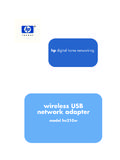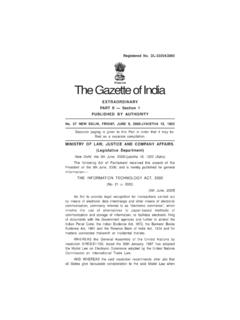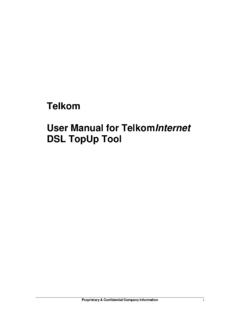Transcription of The Internet and Its Uses - pearsoncmg.com
1 CHAPTER 1 The Internet and Its UsesObjectivesAfter completing this chapter, you should be able to answer the following questions:nHow is the Internet evolving?nHow do businesses and individuals use theInternet?nWhat is the importance of standards in the continuing growth of the Internet ?nWhat is the role of an Internet service provider(ISP)?nHow does the hierarchical structure of theInternet allow the efficient movement of information?nWhat are a point of presence (POP) and anInternet Exchange Point (IXP)?nWhat types of devices do ISPs use to provideservices?nWhat is scalability, and why is it important inthe ISP network?nWhat support teams work at an ISP, and what istheir purpose?Key TermsThis chapter uses the following key terms.
2 You can find the definitions in the page 2electronic commerce (e-commerce) page 2 Request for Comments (RFC) page 3 Internet service provider (ISP) page 4bandwidth page 4digital subscriber line (DSL) page 5 Metro Ethernetpage 7point of presence (POP) page 7 Internet Exchange Point (IXP) page 7 Network Access Point (NAP) page 7 Tier 1 ISP page 9 Tier 2 ISP page 9 Tier 3 ISP page 9 Internet Control Message Protocol (ICMP) page 9transport network page 12 DSL access multiplexer (DSLAM) page 13cable modem termination system (CMTS)page 13scalable network page 14 The globalization of the Internet has occurred faster than anyone could have imagined.
3 The manner inwhich social, commercial, political, and personal interactions occur is rapidly changing to keep pacewith the evolution of the Internet . This expansion has created a wider audience and a larger consumerbase for whatever message, product, or service can be delivered. Today millions of individuals areconnected to this global network, and the number is growing. This chapter discusses the importance ofstandards in maintaining this rapid growth and provides an overview of the hierarchical structure ofthe Internet and the role of the II of this book includes the corresponding labs for this Is the Internet ?The Internetis a worldwide, publicly accessible network of networks. Through interconnected com-puter networks, the Internet enables individuals and businesses to share information, resources, andservices.
4 Because no single individual or group of individuals controls the Internet , it is imperativethat certain rules and guidelines are adhered to so that it can function Internet and StandardsIn the beginning, the Internet was used strictly for scientific, educational, and military research. In1991,regulations changed to allow businesses and consumers to connect as well. Since that time, theInternet has grown rapidly and now covers the globe. New technologies are continuously being devel-oped that make the Internet easier and more attractive to use. Online applications are available to theInternet user, including e-mail, web browsing, streaming music and video, online gaming, and way people interact, share information, and even do business is changing to keep up with the con-tinuous evolution of this global network.
5 The Internet is creating a wider audience and consumer basefor whatever message, product, or service can be delivered. For many businesses, having Internetaccess has become critical, not only for communication, but also for day-to-day operation. Thisincludes e-commerce, communications, and collaboration and training, as shown in Figure 1-1 anddescribed in the next commerce (e-commerce)isany business activity that can be conducted over the web. Thisincludes using web space for advertisements, brochures, and catalogs, as well as ordering and distributionservices. Companies can sell products and services over the Internet from their own websites, throughauction sites, or through affiliated refers to any electronic method of communication, such as the use of e-mail, instantmessaging, and online chat.
6 In addition, many businesses use internal phone systems that operate overthe Internet using IP phones and voice over IP (VoIP) technology to reduce phone at a Small-to-Medium Business or ISP, CCNA Discovery Learning GuideFigure 1-1 Common uses for the InternetChapter 1: The Internet and Its Uses3 EmployeesIntranetBusinessHome OfficeCustomersInternetCollaboration and TrainingE-CommerceCommunicationsCollabor ation and TrainingThe Internet enables the sharing of documents, presentations, and spreadsheets among users aroundthe world. It allows teams of people to work together virtually from remote locations for business andtraining purposes. Examples include videoconferencing, virtual meeting places, virtual classrooms,online learning, online bulletin boards, FTP sites, and password-protected databases and the increasing number of new devices and technologies coming online, it is important that allusers and technologies adhere to a set of rules or guidelines.
7 This allows services such as e-mail to bereliably delivered to all users. These rules and guidelines are known as Internet standard is a set of rules for how something must be done. Networking and Internet standards ensurethat all devices connecting to the network use the same set of rules. By having standards, different typesof devices can send information to each other over the Internet . For example, an e-mail message isformatted, forwarded, and received by all devices in a standardized manner. If someone sends an e-mailvia a PC, someone else can use a mobile phone to receive and read the e-mail as long as the mobilephone uses the same Internet standard is the end result of a comprehensive cycle of discussion, problem solving, andtesting.
8 When a new standard is proposed, each stage of the development and approval process isrecorded in a numbered Request for Comments (RFC)document so that the evolution of the standardis of Internet standards help define the rules for how devices communicate on different standards are developed, published, and maintained by a variety of include the International Organization for Standardization (ISO), Institute of Electrical andElectronics Engineers (IEEE), Internet Corporation for Assigned Names and Numbers (ICANN), Internet Assigned Numbers Authority (IANA), and Internet Engineering Task Force (IETF). Becausethese organizations create and maintain standards, millions of individuals can connect to the Internetusing a variety of devices, including PCs, cellular phones, handheld personal digital assistants (PDA),MP3 players, and even and ISP ServicesRegardless of the type of device an individual or business uses to connect to the Internet , the devicemust connect through an Internet service provider (ISP).
9 An ISP is a company or organizationthrough which a subscriber obtains Internet access. A subscriber can be a business, a private consumer, a government body, or even another connect to the ISP through a Point of Presence (POP) using a variety of access technologies. Inaddition to offering connection to the Internet , an ISP can offer a variety of other services:nFTP hosting:The ISP provides the server and application software for a business FTP and media hosting:The ISP provides the server and software to allow a businessto provide streaming media such as music,video,or applications such as online support:Many businesses do not have the in-house technical expertise to managelarge internal networks.
10 Some ISPs provide technical support and consulting services for an additional over IP:A business can save on long-distance telephone charges, especially for internalcalls between geographically distant offices, by using co-location:A business may opt to have some or all internal network equipmentphysically located on the ISP hosting:The ISP provides the server and application software for storing web pages andweb content for the business Activity 1-1: Which ISP Is Best? ( )In this activity,you determine the best ISP for a given scenario. Use file d2ia-112 on the CD-ROMthat accompanies this book to perform this interactive activity. Internet Service ProvidersAlthough ISPs offer their clients many different services, their main role is to provide a connection tothe Internet .


















